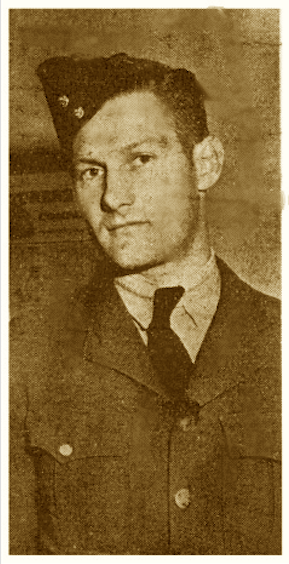
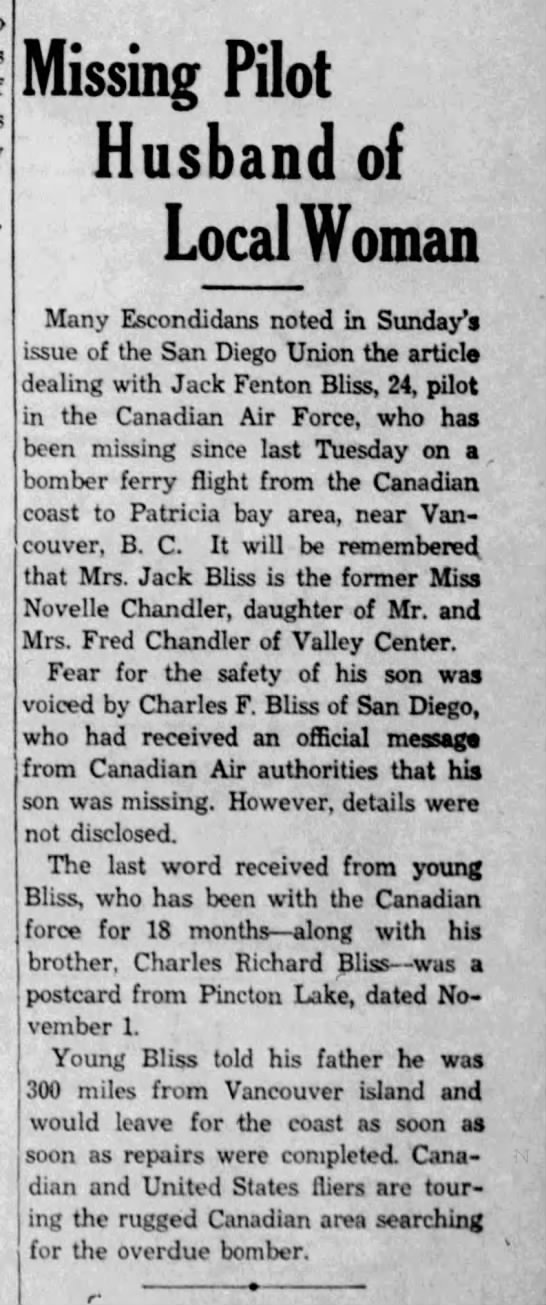
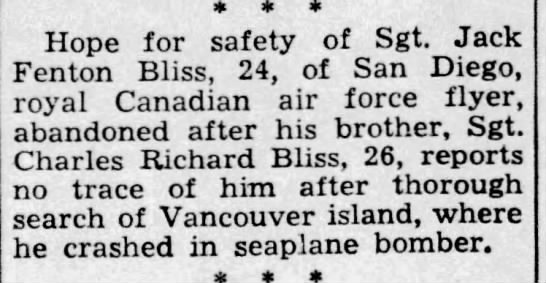
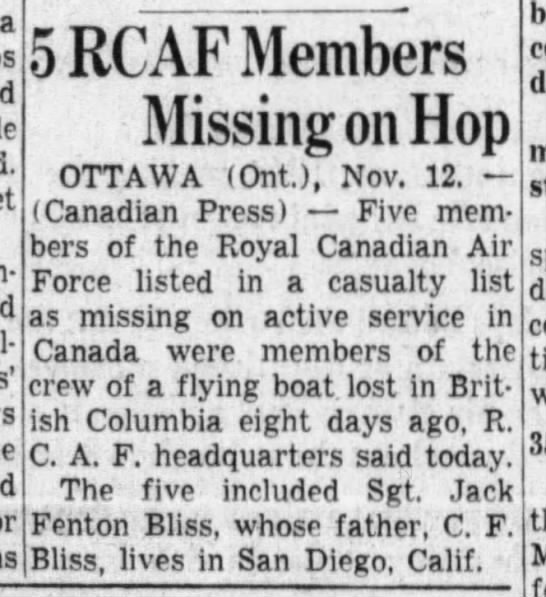
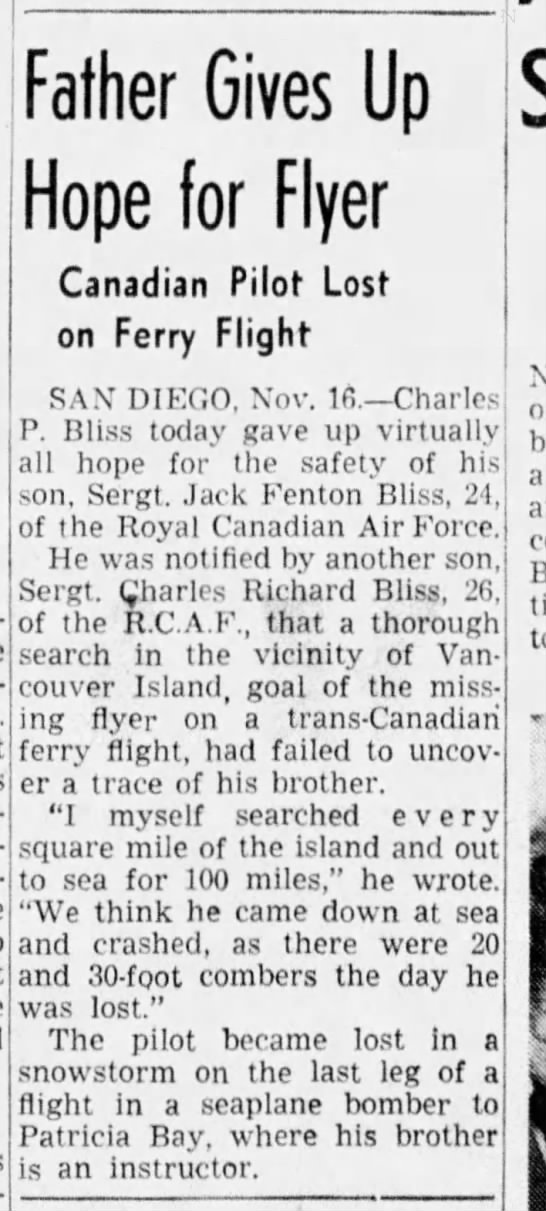
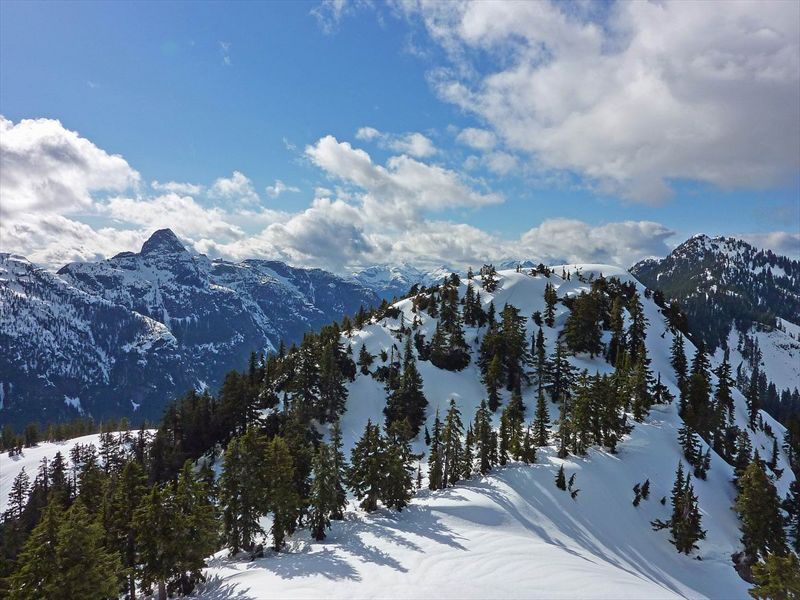
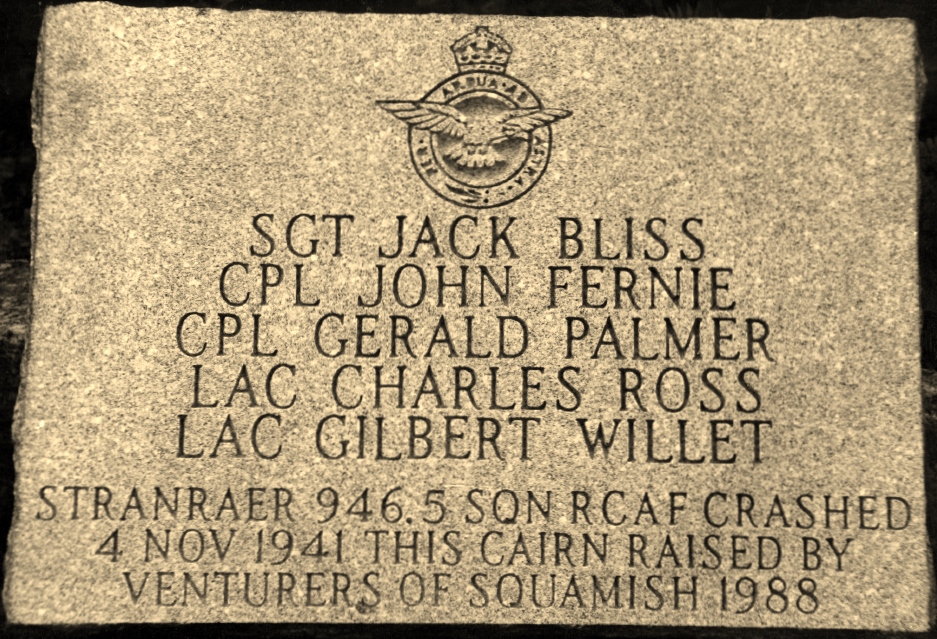
December 31, 1916 - November 4, 1941







Jack Fenton Bliss, born in Fresno, California, was the son of Charles Frederick Bliss (1890-1974) barber, and Ruth Mary (nee Spalding) Bliss (1898-1924). Mrs. Bliss died from post-partum pneumonia. One sister died at birth. His brothers, Charles Richard Bliss and Eugene Walter Bliss (1922-2014) joined Jack in Vancouver to enlist in the RCAF. Other siblings were listed: Malcolm Lee Bliss (1928-2012) and one sister, Ruth Amelia Jackson (1918-1939), plus W. Dale Bliss (1927-2004), Gustave Ernest Bliss (1931-2015), Lonny Dorwin Haptonstall (1935-2016) and Lillian Bertha Wilson. His stepmother was Florence Matilda (Wolfe) Gilmore (1906-2001). (Dale served in WWII with the US Navy, Gustave and Lonny served with the US Army and USAF, in Korea, and Eugene was a POW during WWII.). The family was Baptist.
Jack married Clara Novelle Chandler on July 17, 1937 in Yuma, Arizona. They had a son, Gary Fenton Bliss, born June 2, 1939. They resided in El Cerrito, California. She was Mrs. Clara Callaway by November 1941. Nellie M. Chandler, mother-in-law to Jack filled out the estates form. (Jack wrote that Nellie Chandler was his ‘aunt’ in August 1940, leaving her his estate, that he was unmarried and had no children.)
He indicated that he had 71 hours and 31 minutes solo flying experience and ten hours dual; passenger: 15 hours. “I have also went [sic] to Snyder’s Continuation School in San Diego, California for six months. My subjects were machine shop and workshop.”
Jack enlisted in Vancouver BC on August 24, 1940, indicating he was single on his attestation form. He had been living in San Diego, California prior working as a hardwood floor contractor for four years. He hoped to remain in “military flying or civil flying.” “Good type of young man. American: very keen. Very anxious to fight for our country. Clean cut, alert, smart. One of three brothers. Came from San Diego to enlist.”
He listed his hobbies as shooting and flying, enjoying swimming and basketball. He smoked about fifteen cigarettes per day and occasionally drank alcohol (three beers a month). He stood 5’ 11 ¾” tall, weighing 164 pounds. “This is the third brother of all whom had had accelerated pulse rates.” He had brown hair and dark brown eyes, with a dark complexion.
Jack started his journey through the BCATP in Toronto at No. 1 Manning Depot, August 28, 1940. He was at Eastern Coastal Command before being sent back to Toronto and No. 1 ITS. “212th out of 224 in class. Good type. Clean cut. Should make a good full-out fighter pilot.”
He was then sent to No. 3 EFTS, London, Ontario until December 23, 1940. “Above average. Good instructor material.” Ground training: “Well behaved and hard working. 12th out of 24 in class.”
He continued his training at No. 6 SFTS, Dunnville, Ontario, December 24, 1940 until March 9, 1941. “Progress good. Navigation average. Above average.” Ground training: “Very satisfactory. Good effort shown throughout.” 17th out of 44. Very hard worker, interested and a good soldier.” He was authorized to wear the Pilot’s Flying Badge on March 5, 1941.
He was sent to No. 13 (OT) Squadron, Patricia Bay, BC March 10, 1941. It was here he completed a course of instruction in Bomber Reconnaissance. (“Above average ground subjects, a sound reliable flying boat pilot”), then to No. 4 (BR) Ucluelet, BC June 3, 1941. He was then sent to Halifax, Nova Scotia, July 8, 1941 and attached to No. 5 (BR) Squadron, Dartmouth, Nova Scotia July 15, 1941.On November 4, 1941, Stranraer 946 was lost as the airplane and crew headed towards the BC coast from a stop at Penticton, BC hitting a snowstorm.
Crew: *Bliss, Jack Fenton, Sergeant, R58599, *Palmer, Gerald Searing, Sergeant, C4216 *Fernie, John Robert Bruce, Corporal, R50490 *Ross, Charles Murray, Leading Aircraftman, R65863 *Willett, Gilbert Fowler, Leading Aircraftman, R65048
On November 25, 1941, a letter, written by G/C F. V. Heakes for Chief of the Air Staff was sent to families of the men aboard Stranraer 946. “It is with deep regret that we have to advise you in reply to your letter of November 18, 1941, that the Stranraer aircraft in which your son…was lost while en route from Penticton BC to Patricia Bay, Vancouver Island, British Columbia is still missing…the journey on which the aircraft was lost was a very short one, particularly as the longest and most difficult part of the trip was from Ottawa had already been completed. The aircraft was in radio communication with the range to Hope British Columbia but lost communication at about that point. It was apparently later seen over Vancouver Island, only a short distance northwest of its final destination. During the time the aircraft was en route from Penticton, the weather on the coast had badly deteriorated and visibility had become very poor. For this reason, other aircraft of this type had returned to base and it would seem fairly certain that the aircraft seen was the one which is missing.
The aircraft carried fuel for a minimum range of 600 miles and for this reason search for it has proceeded a distance of several 100 miles up and down the British Columbia coast, all of the inlets and inland waterways and out to sea. Additionally, the search has covered the mainland, Vancouver Island, and the northern inland region of the United States. Not only have our own aircraft searched but the United States Air Service has have also assisted by having their aircraft cover wide areas for us. Naval vessels have also collaborated in the search. The search is still being conducted and every rumor is being followed up in the hope a successful end might be made to our efforts. The aircraft was new and in perfect condition, while the pilot was experienced on this type and had flown at operationally on the coast. Aviation has unhappily always presented those engaged in it with problems of this kind, and while every effort and precaution is exercised to ensure safety of personnel and aircraft, these efforts sometimes fail. Where they do fail, as in this case, it is natural that relatives of men missing should feel concerned as they ordinarily have little knowledge of the organization that exists to ensure safety of aircraft and to render aid when necessary. You may be reassured that no effort to discover this last aircraft has been or will be spared.”
In October 1947, the plane was located by prospector Basil Zurbriggen. [Interestingly, he had been considered missing in September 1947.]
Jerry Vernon, CAHS Vancouver Chapter President wrote on the RAF Commands Forum in 2011 indicating that a cairn was built at the site, approximately ten miles southeast of Squamish, British Columbia. The airplane flew into the hillside at the end of Indian Arm between Indian Arm and Squamish. “Any logging roads into the site were washed out long ago. The aircraft just caught the top of the ridge, otherwise they would have been over the top and looking at Howe Sound in the distance. There is a wooden cross at the crash site with the names of the crew, but vandals had partially burned it.” Details: “Reading some of the detail on 946....it had left RCAF Stn. Rockcliffe on 07 Oct 41. There was a change of pilot at Regina on 18 Oct 41, when F/O Coburn came down with acute appendicitis. Sgt. Jack Bliss took over as pilot. They landed at Brooks, Alberta, on 21 Oct 41 and bought gas from the Brooks Garage. One wingtip was damaged on the end of the CPR pier at Penticton on 23 Oct 41, and this took 12 days to repair. The aircraft departed from Okanagan Lake in poor weather on 04 Nov 41. At 1300 hrs, the aircraft reported that they were ‘SE of Vancouver in the North Sector of the Princeton Range, flying blind and descending to try and make contact with the ground.’ They were advised to remain at 11,000 ft. until they had crossed the Vancouver cone marker. At 1346, the last radio messages from the aircraft said that ‘We are lost in a dense snowstorm over land and are nearly out of fuel. No position can be decided.’ A large scale search was conducted, particularly in the Port Alberni and Mount Arrowsmith areas [Vancouver Island], as an aircraft had been heard in that vicinity. The search was discontinued on 27 Nov 41. The plane was found in heavy timber on 06 Oct 47 by an old trapper by the name of Zurbriggen. A cairn was erected, and a memorial service was held for the five lost airmen.”
In late October 1955, families received a letter from W/C W. R. Gunn, RCAF Casualties Officer, for Chief of the Air Staff who indicated that their sons did not have a known grave and their names would appear on the Ottawa Memorial.
In the spring of 1986, the Hellcat Venture Company erected a monument to replace the deteriorated cross. Money was raised to place a memorial plaque in 1988. In 2012, a book was published to commemorate the men lost aboard Stranraer 946. See links below.
LINKS: